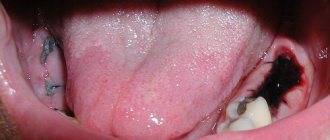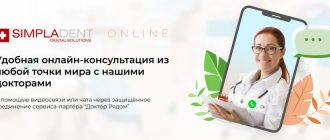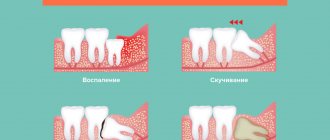Parents always have a number of concerns regarding the health of their children. For example, it is important to know how a mother herself can correctly and quickly pull out a loose baby lower or upper, front or chewing tooth, fang or incisor, at home so that it doesn’t hurt, the better with dental floss or sewing thread, or without them, just with your hands, Is it even possible to do this yourself, how to help you heal faster and survive the recovery period on your own and painlessly, without complications and at home.
When they start to fall out
This phenomenon can be encountered when the child turns 5-6 years old. It occurs due to the fact that the jaws begin to grow. It is completely painless for most children, due to the fact that during the growth of the radical replacement, the roots of baby teeth are reabsorbed. They become mobile and then fall out. This is ideal.
There are cases when improper formation is observed, especially of premolars, and very rarely of incisors and canines. Due to the violation, resorption does not occur on time. Careful removal is required so that they can grow healthy and even in the future.
Lasts up to 10-12 years, depending on the individual characteristics of the body. Interestingly, in girls it begins earlier and proceeds much easier and faster than in boys.
Preparatory stage
Feed your baby before the procedure!
As soon as the tooth hangs on a thread-like basis, no pain is felt when loosening to the sides, you can plan the extraction procedure. You should first examine your mouth to make sure there is no inflammation or swelling.
During preparation, it is worth feeding the child, because after the manipulations you should not eat for 2-3 hours.
After this, brush your teeth with paste and brush. You can also use additional rinse aid. All funds used are prepared in advance. They need to be disinfected with high temperature or antiseptic. A set of specific materials is collected depending on the method of tooth extraction used.
Should I rush to delete it?
Parents are interested not only in how to correctly pull out a child’s tooth, but also when it can be done. A clear answer to the question is not recommended without medical indications. Because the rudiments have not yet fully formed. They will not erupt for a long time. The absence of at least one element of the dentition leads to the fact that the rest begin to slide, taking up free space, which leads to an incorrect bite. Those that should be in a specific place will not come out before their due date. This means that when the time comes, they simply will have nowhere to grow.
Among the dangerous consequences of this procedure:
- the appearance of painful and unpleasant sensations during teething;
- change in diction, habit of burring;
- incorrect jaw structure;
- problems with digesting food.
Therefore, it is better to refrain from deleting in advance if there is no reason for this.
Alternative methods of teeth extraction
Baby teeth have roots. A year before they fall out, they begin to dissolve. When this process comes to an end, the child begins his favorite game of loosening the tooth with his tongue and fingers. Normally, the replacement should occur without pain and outside help. If this does not happen, then before pulling out a tooth at home you need to carry out simple preparation:
- Eat. You should not eat for the first 2-3 hours after the procedure. There is no need to increase the child’s stress by hunger.
- Brush your teeth. Once pulled out, there will be a hole in the gum that may begin to bleed. It is better that by this time there is a minimum amount of bacteria in the mouth so that inflammation and suppuration do not begin.
- Talk. Most children find it scary to watch someone try to pull out their teeth. They do not believe that everything will pass without pain. Therefore, the child needs to be distracted, talked to, reassured, saying that this will only be a little unpleasant.
- Disinfect your hands. It is best to use the antiseptic Chlorhexidine. It is cheap, effective, safe and tasteless. On the other hand, it is enough to wash your hands thoroughly with soap.
To ensure that your child is not in pain, you can give him a painkiller tablet 5-10 minutes beforehand or lubricate his gums with a special gel. Then, having prepared a swab with an antiseptic to immediately cover the hole, you can begin the procedure.
It is better to turn tooth extraction into a game or use a fairy tale about a mouse, an owl or a tooth fairy. By being distracted, the child will be less afraid and even feel less pain.
We resort to using our fingers
Be sure to wash your hands before the procedure. You can take the tooth with two fingers, twist it along the axis, and press on the upper part to help the roots detach from the gums. You don't need to put in much effort.
On a note! Even without your permission, children will reach for the sore spot in the mouth with their hands. It is useful to have a preliminary conversation about the dangers of dirty fingers and the possible consequences of non-compliance with sanitation.
Napkin
This method is considered more effective than using thread. It is better if adults do not put their hands in the child’s mouth. In most cases, it is enough for him to completely loosen the tooth with his tongue, and then pull it out with clean hands. If the baby is afraid, you can take a clean napkin, grab the tooth more firmly and shake it, and then gently pull it out so that it doesn’t hurt.
If you can’t pull out a tooth right away with a thread and a napkin, it’s better to wait until it completely loosens. Otherwise, you can damage the gums and even the growing permanent ones.
Food
The famous Soviet toffee not only perfectly “cleanses” fillings from teeth, but also helps to pull them out.
In general, any viscous and hard food can be used for this purpose: apples and pears, nuts, bread-crusted sandwiches. Trying to specifically pull out a tooth this way may not be entirely hygienic.
But if the child categorically does not allow either the parents or the dentist near his mouth, everything can be done “completely by accident.”
Indications
Among the cases when the doctor may insist that the milk needs to be vomited:
- advanced caries, which can cause infection in the oral cavity;
- cyst;
- a loose element of the dentition injures the gums, which leads to inflammation;
- long-term spontaneous loss;
- chip, crack or other injury;
- orthodontist indications;
- phlegmon;
- periodontitis;
- fistula;
- sinusitis.
If there are such reasons, it is necessary to remove the traumatic element ahead of schedule so that it does not lead to serious diseases of the oral cavity.
Causes of loss of baby teeth
As a rule, at the age of 5, a child’s first milk tooth begins to loosen. This is an absolutely natural, physiological process that happens to every child: the root of a baby tooth dissolves, the tooth begins to be held in place only by the gums, gradually loosening and eventually falling out. However, if the tooth fell out much earlier, this situation can no longer be considered normal. Baby teeth fall out prematurely due to:
- Tooth injuries
- Vitamin deficiency
- Rakhita
- Diabetes
- some genetic diseases
In most cases, these diseases can be treated, the main thing is to seek medical help in time.
If a tooth falls out a year or more ahead of schedule, this can lead to improper development of the bite and slow jaw growth. In this case, long-term orthodontic treatment will be required.
In addition, parents should pay attention to the following points:
Long process of falling out
If a child's baby tooth becomes loose for a long time but does not fall out, it can cause discomfort to the child, preventing him from eating and speaking. The gums around the tooth may become inflamed and painful.
Deterioration of the child's well-being
If a child has a loose tooth and, as a result, the temperature rises, loss of appetite, nausea and vomiting occur - first of all, seek advice from a pediatrician, and secondly - from a dentist.
Is it possible to pull out baby teeth yourself: when is it allowed?
You can help your child yourself only in a few cases. The main thing is that everything has its time. There are elements of the dentition that fall out naturally at the age of 5-8, or those that children lose closer to adolescence. Parents need to know about the location and timing of each one. If a loose element is about to fall out in time, you can help it, and if not, consult a doctor.
You should not run to the doctor if the second row appears. This sight is unaesthetic and often causes horror and an urgent visit to the dentist. This process occurs due to the fact that children have an excess of beneficial microelements in the body; accordingly, the formation of new ones occurs faster than the resorption of milk roots. Removal is not required; after timely loss, the root one will take its place. If this does not happen, braces may be available to help.
How to make a tooth fall out on your own
You should not insist on manipulation if the child is terrified of it.
You can apply the method without using your fingers or other tools. For example, offer your child to eat an apple or carrot. When biting off pieces of food, there is enough force on the tooth to cause it to fall out on its own. A special loosening of the connecting rod with a finger or tongue can also provoke rapid loss of the cutter.
It is important not to leave the baby alone while eating food; this is necessary to control the process and prevent swallowing of the tooth after it is detached from the base.
Possible complications
An increase in temperature, even a slight one, indicates the development of an infectious-inflammatory process, and therefore requires urgent medical attention.
Other possible hazards include:
- change in bite;
- speech defects;
- decreased chewing function;
- prolonged bleeding from the socket, wound infection;
- pain in the area of removal;
- general weakness, hyperthermia.
Treatment of complications is very important. They can lead to dangerous consequences, including sepsis. If persistent hemorrhage, the presence of pus, severe pain, or fever are detected, it is necessary to urgently consult a specialist.
The wound will heal
During the natural process, when an old tooth falls out, a molar very easily erupts in place of soft, non-healed tissues. In case of mechanical intervention and tightening of the wound, a scar appears, through which it will be very difficult to break through. This will lead to pain and possible abnormal growth of the new tooth.
Damage to the primordia
If the technique is violated during removal, the growing ones can be damaged. Unformed tissue is very sensitive to mechanical stress, which can result in significant problems in the future. If you decide that you are definitely pulling out a child’s tooth at home, you should be prepared for:
- curvature, irregular formation;
- in places of damage to the top layer - the formation of caries;
- darkening of the enamel;
- displacement.
Therefore, it is necessary to resort to such intervention only when indicated.
The bite is disturbed
The most common problem that occurs when pulling out incorrectly is displacement. Associatively, you can imagine it like this:
- Dairy is a definite benchmark for growth.
- The root one rests on the roots and strives upward.
- After mechanical impact, the direction is lost, which leads to the fact that the dentition moves. Correction with braces may be required.
This is only one of the possible development options. If you remove them too early, the remaining ones will try to move into the free space. In this situation, there will simply be no room for the new one to erupt; it may come out sideways or second row, after which a lengthy adjustment will be required.
Overload of the masticatory apparatus
Each incisor, canine, molar or premolar has its own function for tearing and processing food. When one of the structural elements of the jaw is missing, the load is redistributed. Due to the fact that the remaining teeth are not designed for it, they are damaged and deformed. There is a possibility of tooth decay, displacement, gum disease and many other problems in the future.
Dangers of Home Removal
There are enough of them to make a rational choice in favor of professional dentists:
- there is a high risk of infection, because introducing dirt and infection into the hole will lead to suppuration;
- damage to molar primordia can cause damage to adult teeth;
- when tying with thread and other improvised means, the gums are often injured;
- displacement of the dentition, changes in the bite, subsequently problems with digestion and diction.
It is better to trust the experience of professionals than to risk the health of the child.
How to tie a thread to a tooth to pull it out
Is it really possible to pull out a tooth the old fashioned way - with thread? Is the process tolerable? It depends on what tooth we are talking about.
If you are talking about a baby tooth that barely stays in the gum, then yes, you can do it the old fashioned way)
If we are talking about an adult and teeth that have already acquired roots, then pulling out a tooth with a thread and a door is out of the question. This is simply impossible.
So, if we are talking about an adult and root teeth, then you should definitely go to the doctor and remove the tooth as expected, with pain relief and normal removal tools.
It also happens that you just need to touch it with your finger and the tooth almost falls out on its own and there is no pain at all, but try to pull out the “eight”, which is also called a wisdom tooth, and it’s unlikely to work.
This is interesting: Runny nose during teething in children: how to treat snot
Not only will it be very difficult, if not impossible, to hook it due to its inaccessibility, but it also sits quite firmly and some dentists prefer not to bother with it and do not even try to rip it out like other teeth, but immediately send it for surgery .
So, in this case, it all depends on the circumstances and each case is individual, because sometimes it is easier to break your neck trying to pull out a tooth than to part with the tooth itself in this way.
How to pull out a tooth?
Everyone knows that a dentist should take care of your teeth, and everyone also knows about visiting him twice a year. However, despite the fact that today nothing can be treated without anesthesia, many of us are still afraid to go to the dentist. Well, if everything seems to be clear with treatment, there’s no way you can handle it on your own, but with teeth pulling it’s much more complicated.
Almost everyone is afraid to have teeth removed, especially children, who, due to their age, have to undergo the procedure of removing baby teeth quite often. Many parents are wondering how to pull out a baby tooth without hurting the child?
Baby tooth
History knows many ways to extract a tooth from a child. In many countries, special ceremonies are dedicated to the loss of the first baby tooth. We know about the tooth fairy, who exchanges lost teeth for coins, about the fact that a tooth must be given to a mouse or a dog so that the permanent teeth are healthy, and so on.
Indications for the procedure
Dentists try to preserve every unit in the oral cavity (with the exception of wisdom teeth) to the last. Unfortunately, saving teeth is not possible in all cases. Among the indications for extraction of elements from the oral cavity are:
- loosening of the unit or its excessive mobility;
- destruction of more than 2/3 of the crown;
- supernumerary units that interfere with full prosthetics;
- purulent processes in the root system of teeth.
It is prohibited to remove units yourself if the following symptoms are present: fever, swelling of the cheek, inflammation in the oral cavity, severe destruction of the crown.
Preparatory activities
Preparation for safe extraction of the affected unit from the oral cavity includes 4 preparatory stages:
- Moral attitude. It is necessary to realistically assess your capabilities regarding the manipulation. You can remove yourself only those units that are wobbly. If the tooth sits firmly in the gum, then it is better to seek help from a dentist or surgeon.
- Carrying out thorough oral hygiene. Before the procedure, be sure to brush your teeth with toothpaste, a brush and treat the oral cavity with an antiseptic balm. Suitable medications can be purchased at a pharmacy. When choosing a mouthwash, preference should be given to those that contain alcohol.
- Taking painkillers. A tablet taken 30-40 minutes before manipulation will reduce the severity of discomfort. Before using the drug, it is advisable to read the instructions for its use and possible side effects.
- Place gauze on the problematic element.
Before removing teeth yourself, it is important to prepare all the necessary equipment:
- container for removing saliva that appears during manipulations;
- antiseptic solutions;
- tampons and gauze wipes;
- mirror for beams of visualization of the working area.
Before removing a tooth in the clinic, the surgeon performs local anesthesia of the working area using an injection. Anesthesia is carried out with a powerful analgesic with injection of the problem area from several sides. The drug begins to act 10 minutes after injection.
Local anesthetics and gels with anti-inflammatory effects are not used for pain relief. After eliminating the problematic element, drug components can penetrate into the tooth socket and cause an inflammatory process or increase the risk of its suppuration
At home, a person without special knowledge and skills will not be able to competently perform anesthesia.
In this case, it is recommended to use one of the most powerful non-narcotic drugs - Ketarol or Ketanov. The drugs partially block the transmission of pain impulses entering the brain.
However, oral administration of tablets cannot compare with the effect of professional pain relief.
Removal technique at home
Sometimes it is difficult for a person to determine on his own which of the units causes discomfort. This is due to the fact that toothache can radiate to neighboring areas and spread to half of the jaw.
The procedure for extracting problem teeth at home includes:
- Thorough hand washing with soap.
- Apply a gauze pad soaked in an antiseptic to the problem area.
- Loosening of the tooth in different directions with its simultaneous upward movement. A tooth can only be pulled out of its socket using a systematic loosening technique.
It is powerful to pull a tooth out of its socket only with the help of a systematic loosening technique.
There is another way to deal with the problem - pull out the tooth with floss. To do this, you need to take 20-30 cm of thread and tie it to the base of the problem tooth. The thread must be tight enough, otherwise it will come off during sudden movements.
Do not use doors or other foreign objects while using the thread. The rope should not come into contact with the soft tissues of the mouth, otherwise damage to the latter may occur. The floss method is more commonly used to remove loose baby teeth.
Blood that appears during the procedure must be spat into a previously prepared container. After the manipulations, the mouth is rinsed with an antiseptic. There should be no remains of blood or pieces of tooth left in the cavity. After self-extraction of the unit, it is not recommended to eat or drink for 2 hours.
It is advisable to apply a cold compress to the problematic side (to relieve swelling of the soft tissues). Cold also minimizes the risk of infection of the hole after manipulation. Smoking and consuming alcoholic beverages are prohibited for 5-6 hours after the procedure. It is not advisable to give the body excessive physical activity during the day.
It is not possible to pull out a tooth painlessly. Without a professional procedure, it is almost impossible to completely stop pain impulses in the brain.
There are several recommendations that a person should consider when getting rid of a tooth on their own:
If the procedure could not be completed on your own, you should urgently contact a surgeon. If providing urgent professional help is not possible, then you should take a painkiller tablet and minimize the chewing load on the problem area of the jaw.
After successful completion of the manipulations, you should monitor the condition of the hole throughout the week. Pain and suppuration at the site of the removed unit is a reason to contact the dentist. Before visiting a doctor, the painful area should be treated with antiseptic agents (Chlorophyllipt, Miramistin).
Features of milk element extraction
It is easier to pull out a baby tooth than the root elements. This is due to its fragile root system and small size. Often children's teeth fall out without pain due to drying out of the roots or germination of a permanent unit.
If the unit sits tightly in the hole, then you can resort to the following algorithm for pulling out a baby tooth:
- Inspect the element and assess the possibility of independently removing it from its place. Adults should evaluate the child’s tooth mobility and its visual differences from other units in the series. It is also necessary to ask the child about the pain of the element. It is prohibited to pull out a baby tooth at home if there are soft tissue swellings or abscesses near it. In this case, you need to show the patient to a pediatric dentist.
- Pay special attention to pain relief. They are usually not used when removing milk units. If it is painful for a child to press on a tooth, then it will not be possible to do without tablets. In this case, it is necessary to select the drug that is suitable for the child’s age.
This is interesting: White coating on the tongue - causes of formation and treatment methods
It is important that the child remains calm during the tooth extraction. Otherwise, parents will need to seek help from a dentist.
If a child allows a tooth to be pulled out, then first a piece of gauze moistened with an antiseptic should be placed on the problem unit. After this, the adult should quickly pull the baby tooth upward. Sudden movements often frighten children, but cause them less discomfort during the procedure. You can pull out a child’s tooth at home only if the tooth is loose.
Hard foods, such as apples and carrots, can loosen baby teeth (especially incisors and canines). In this case, you need to make sure that the child does not swallow the dropped element. After the procedure, the wound is thoroughly treated with an antiseptic. To normalize the child's moral state, one-time use of sedatives is allowed.
To eliminate bleeding after removing a baby tooth, use a gauze pad. The tampon is removed after the bleeding has completely stopped. If the tooth extraction procedure is carried out correctly, the regeneration of the hole will occur the next day. If after a few days the baby experiences redness and pus at the site of the removed unit, he should be shown to a doctor.
Molar
How to pull out a molar tooth? With molars everything is more complicated. You can't remove them with thread. In the old days, however, various methods of removing teeth were practiced, but this was due to the banal lack of dentists. Today, teeth are removed by a surgeon in a dental clinic.
- So you go to the doctor. The dentist examines your teeth, and if you need extraction, he gives an injection with an anesthetic, after asking if you are allergic to the drugs.
- When the anesthesia takes effect, the doctor will remove the tooth with a special tool. This procedure usually takes a little time. If necessary, they may order an x-ray to make sure there are no fragments left.
- After the tooth is pulled out, a tampon is placed on the socket, which you must hold in your mouth, clamped with your teeth, for some time (usually about half an hour) to avoid bleeding.
- The main thing you should know after tooth extraction is that you should never rinse your mouth. Your doctor should warn you about this.
- The hole after tooth extraction heals and tightens in about 2-3 weeks.
- If after the operation you have some troubles: fever, abscesses, pain, and so on, then you should not self-medicate and wait for everything to go away on its own, you need to urgently go to the dentist, who will look at what your problem is and how to solve it .
Thus, you must solve the question of how to pull out a tooth competently. It is best, of course, to see a doctor, but if this tooth is a baby tooth, then you can, in principle, cope on your own, but still, be careful so that there are no complications.
Have your child wash their hands thoroughly with antibacterial soap to remove as many germs as possible before they put their fingers in their mouth. Now he is ready to start trying to pull out the loose tooth.
Rock the tooth back and forth. Do this until it is as loose as possible to painlessly extract the baby tooth.
Try pulling the tooth up with your fingers. If it refuses to come out, repeat step 2. If the tooth is well loosened, you should be able to pull out the baby tooth without any problems.
Try eating an apple with a loose tooth. Sometimes it helps.
If your child is in pain, wait until the tooth becomes more loose or let time take care of it—when the tooth is ready to fall out, it will.
Press a towel or gauze pad against the bleeding gum as you pull the tooth to stop the bleeding. Tilt your child forward slightly to prevent him from swallowing blood, which can cause stomach upset.
Features of wisdom teeth removal
Wisdom teeth are considered the most problematic units. They are difficult to treat and remove. Often the process of the emergence of eighth molars on the gum surface is accompanied by pain.
Wisdom teeth are more susceptible to caries due to the excessive fragility of the enamel and the difficulty of caring for them. Eights are located at the end of the row, and it is difficult to clean them properly
It is not recommended to pull figure eights on yourself, since the procedure is associated with a high risk of side effects. There is only one indication for preserving the figure eight – its correct eruption and the absence of pressure on neighboring teeth.
If the problematic tooth is loose, but it is not possible to pull it out in a dental clinic in the near future (due to weekends, the patient’s remote location from civilization or night time), then you can try to get rid of the molar at home.
Inflammation of the socket after tooth extraction and its treatment
Wisdom tooth removal occurs according to the following algorithm:
- hand disinfection;
- assessing the possibility of self-extraction of a unit;
- high-quality cleaning of teeth from plaque and food debris;
- treatment of the oral cavity with balms or chamomile decoction;
- placing a swab soaked in antiseptic into the tooth socket.
It is impossible to rip out a retreated (unerupted) third molar on your own. The procedure can only be performed by a dentist. In this case, the patient can be prescribed various intervention schemes (depending on the complexity of the clinical case) under local or general anesthesia. After a complex operation, a person is usually prescribed anesthetics for 3-5 days.
Disinfection of the hole, possible complications
To stop bleeding, use a gauze swab soaked in hydrogen peroxide or a non-impregnated napkin. Gauze is placed into the hole and pressed well with your teeth. Ice is applied to the outside of the cheek to relieve swelling. Additionally, they take anti-inflammatory painkillers: Ibuprofen, Ketanov, Nise.
The gauze swab is held in the mouth and then spat out. It is important that a protective clot forms at the site of the removed element, which will protect the hole from infection. In the first 24 hours, it is not recommended to actively rinse the problem area to avoid washing out the clot.
For 2-3 days after the procedure, it is allowed to make oral baths with herbal decoctions or purchased solutions. The antibacterial agent is taken into the mouth and left for 2-3 minutes.
Among the main complications after wisdom tooth removal it is worth noting:
- heavy bleeding;
- the probability of leaving a fragment of an element in the hole;
- alveolitis (infection of the hole at the site of the torn unit).
You can effectively stop bleeding with the help of special medications, but only a dentist can prescribe medications in this case. At home, to stop bleeding, it is better to use local agents: hydrogen peroxide, fibrin film, hemostatic sponge.
This is interesting: A child has a toothache: causes, treatment, how to help a child with severe toothache at night
Infectious complications usually occur 3-5 days after self-extraction of a tooth. They manifest themselves with the following symptoms:
- swelling of the cheeks, increasing every day;
- increased discomfort in the jaw;
- sore throat when swallowing saliva;
- bad breath;
- general deterioration of condition;
- temperature rise.
If a person does not respond to these symptoms, there will be a high probability of developing side effects: abscess and cellulitis.
The latter disorder is associated with the spread of the inflammatory process to an unlimited area of the oral mucosa. Treatment of the presented disorders cannot be carried out at home.
It can be fatal, especially if the problem area is heated and attempts are made to squeeze out the abscess.
Treatment of abscess and cellulitis should be carried out by a surgeon and dentist. The doctor develops a comprehensive treatment regimen: using surgery, medications and physiotherapeutic procedures.
Home tooth extraction may not be 100% safe. The procedure is performed only if it is not possible to urgently see a doctor and the situation becomes critical. The correct tactics for eliminating the problem will minimize the negative consequences after manipulation. It is best to entrust the selection of a suitable anesthetic agent and the procedure itself to a doctor.
How to make it fall out yourself
The best and painless option in all respects is the natural process of change. However, it happens that the milk begins to wobble long before it falls out, which brings a lot of discomfort to children and worries parents. There are several ways to speed up spontaneous loss without causing harm.
Tongue loosening
Children are often told not to lick a loose tooth. There is an established myth that new ones may not grow evenly. This statement is completely false. When talking, eating, we constantly touch our teeth. When changing, this is necessary so that the loss occurs faster.
Do not be too zealous and press with your tongue, applying force. Light loosening will be beneficial and will help develop the gums. This should not be allowed if the dairy is not yet very wobbly. When the replacement process just begins, you need to wait the time necessary for root resorption. Otherwise, you can damage soft tissues or the rudiment and cause an infection.
We resort to using our fingers
After watching a video of children having their teeth pulled out at home, many parents decide to repeat what is not the safest and most hygienic option. The hands contain a huge amount of bacteria that will be transferred to the oral cavity. You can miscalculate the force and injure the gums, where an infection will develop.
You can try to loosen it with your fingers without applying pressure. Just moving it a little in different directions. If pain occurs, stop and go to the dentist. It is possible that the infection has already entered the tissue, which is fraught with complications.
Another contraindication is that the roots are still sufficiently attached to the hole. Parents will not be able to check this on their own; it is necessary to consult a doctor who will give recommendations on whether the root canal will appear soon or whether it is necessary to wait a little longer before accelerating the loss.
We clean with special zeal
Toothbrushes are designed taking into account the physiology of the oral cavity. Therefore, it is almost impossible to seriously damage them unless you spend several hours in the bathroom, irritating soft tissues by friction. It is worth increasing the cleaning time by a few minutes and doing it not twice a day, but 3-4.
It is better to go to a clinic, where they will recommend professional soft brushes that do not injure the gums. Hard bristles can scratch and lead to the development of inflammation, gingivitis and periodontitis. Therefore, it is necessary to choose hygiene products for a child during the period of change of bite after consultation with a dentist.
Chewing on solid food
Many self-help tips tell you to eat apples, pears, cucumbers and other tough vegetables and fruits. In part, yes, the chewing process is the most physiological of all, but it can be dangerous.
When a tooth begins to become very loose, the roots in the gums no longer hold well. Accordingly, there is no point of support. When bitten, it easily moves to the side, and sharp clenching of the jaw causes it to break easily. In this situation, parts will remain inside, requiring the help of a dentist, a painful removal procedure, and also the risk of injury to neighboring tissues. Therefore, it is better not to resort to this technique, so as not to make things worse.
At what point can a baby tooth be pulled out?
An important factor that is taken into account when removing a loose baby tooth is timeliness.
It is quite possible to carry out the procedure at home without visiting a dental clinic. However, before helping your child, read the basic rules :
- As soon as a tooth begins to loosen, it is necessary to regularly promote the separation process that has begun. To do this, you need to recommend that the child swing the connecting rod using his tongue. It is also allowed to perform manipulations with your finger, but first you should wash your hands thoroughly, and after completing the procedure, rinse your mouth with a special lotion.
- If you loosen a tooth with your fingers, do not press on it, as painful sensations may appear.
- If the tooth sits deep in the gums and does not separate from the soft tissues over time, then it is better to consult a dentist.
- It is recommended to talk to the child calmly, without escalating the situation. Children tend to be afraid of everything new; explain that the period of changing teeth happens to every person. If you add fairy-tale fragments to the story about how the mouse must take away the old tooth in order to give it a new one - beautiful and strong, or another interesting story, then it will be easier for the baby to cope with anxiety.
Important! If a tooth is pulled out after a certain period of time, a new one will most likely grow back with signs of deformation.
However, there is no need to rush in such a matter either. Firstly, the process itself will be painful, and secondly, the risk of severe bleeding increases.
Dentist on when to remove baby teeth:
Preparing the child
The natural process of changing your bite is usually easy and painless. However, there are times when parental or dental intervention is required. Children are afraid of being hurt, of any outside interference. Therefore, when hesitation is noticed, it is necessary to conduct moral preparation of the child.
It is enough to explain that this is normal. A 5-year-old child will not be able to perceive information correctly, so it is better to use simple figures of speech and a playful form. Mythological children's thinking responds well to all kinds of fairy tales. You can read to your child a special collection of stories dedicated to this phenomenon. Prepare gifts from a fairy-tale character for your patience.
How children's baby teeth are removed in the clinic
The structure of primary teeth is characterized by a number of features. Thin alveolar walls, low crowns, and lateral roots require special care, attention and skill from the doctor during the removal procedure. One wrong move and you can damage the buds of permanent teeth. For this reason, it is very important to find an experienced pediatric dentist who will not only carefully carry out the procedure for removing a baby tooth, but will also quickly find an approach to your child and treat him with care and attention.
Specialists at the Center for Modern Dentistry know how to remove a baby tooth painlessly. Modern painkillers are effective and safe for the child’s body: the child will not feel pain even with complex tooth extraction.
How children's baby teeth are pulled out at home
Before making a decision, it is worth soberly assessing several factors and making preparations:
- Own capabilities. Parents often miss small bumps and inflammation in the gums. They think that swelling is normal. However, any minimal inflammation can lead to cellulitis, malocclusion and secondary infections.
- Compliance. You can't pull those that stand firmly. If they just started to loosen. You can injure soft tissues and cause infection. It is better to turn to specialists than to cause damage that is difficult to repair.
- Tools. You need to prepare special antiseptics in advance and sanitize the oral cavity. Dishes and other things that will help not prolong the unpleasant procedure.
- Psychological preparation. Any movement of the baby, a jerk to the side or severe fright can lead to a violation of the technique, and therefore dangerous consequences. If your child is nervous, capricious, or refuses to sit still, you should trust professionals who know how to remove fidgets.
- Hearty lunch. Afterwards you will not be able to take food or water for 2-3 hours. This time is necessary for the formation of a blood clot in the socket. It serves as a protective barrier against pathogens entering the wound.
When preparing, it’s worth thinking again about whether parents are ready to take the risk and do everything themselves instead of going to the dentist, which will not take more than 15 minutes of time.
How to pull out a child's tooth using floss
The most common method that is often performed incorrectly. Pre-treat the thread with an antiseptic. It’s better to soak it in the solution for a few minutes and let it soak well. It is recommended to use special dental or nylon thread, rather than sewing thread, which can easily break. Then make a self-tightening loop. It is important to secure it well in the root zone; if it slips, it will cause pain.
It is important to perform the technique correctly:
- tear in one quick movement;
- the direction is strictly in the direction of growth, and not sideways or in the opposite direction (you cannot tie a thread to a door handle or other objects);
- If the procedure is violated, fragile tissue without nutrition from the roots may collapse and remain in the hole, which will cause suppuration and infection.
If it doesn’t work out the first time, you don’t need to torture yourself and your child; it’s better to go to a clinic, where the process will be quick and painless.
Using your hands
Be sure to wash with soap and disinfect with an antiseptic, cut off your nails (they are not only a source of infection, but also interfere with grip and retention). Then carry out sanitation of the oral cavity.
Firmly grasp the loose tooth, loosen it, and check its pliability. When you are sure that it will easily succumb to a sharp jerk, pull it out. It sounds simple, but you need to be careful. Tear only in the direction of growth, otherwise there is a high risk of leaving a broken piece in the hole.
If your hands are shaking, there is the slightest fear and uncertainty - you should not take on the task yourself
How to pull out a tooth in different ways at home
Among the existing methods of removing a child’s tooth at home, the following options are popular.
Using thread
For the procedure, a strong thread (about 50 cm) is selected that can withstand strong tension.
Sequence of manipulations:
- wrap the floss around the base of the tooth (as close to the root as possible);
- sharply pull the ends of the thread in the direction opposite to the jaw (but not to the side!);
- rinse your mouth with an antiseptic.
The end of the thread can also be tied to a door handle; when the door is opened and swung open, the tooth will be removed.
Reference! There is no point in using repeated actions; if the base holds the bone tissue tightly, then the time has not come yet; you should wait a few more days.
Removing a tooth with thread:
Using fingers and gauze
To remove a tooth using gauze, follow these rules :
- cut off a piece of sterile bandage, fold it in half or four times;
- put gauze on the incisor, secure it on both sides with your fingers (you need to wash your hands first!);
- start loosening movements - on the upper jaw, swing in the direction of the lips to the palate and back, on the lower jaw - from the lip to the tongue;
- when the tooth becomes mobile, remove it from the socket;
- Rinse your mouth several times with an antiseptic.
With solid food
This method involves eating raw fruits and vegetables that have a solid structure.
More often the role of provocateur is played by: apple, pear, carrot, cabbage. First, the meaning of the procedure should be explained to the child so that he controls the process and does not eat the tooth along with food. Translational loads on a loose cutter help to separate it from the base.
5 ways to remove a baby tooth:
How to care after the procedure
When you pull out a baby tooth yourself, you need to stop the bleeding. To do this, a piece of bandage or gauze is moistened in an antiseptic and pressed against the hole. There is no need to press hard or try to blot all the blood. A blood clot should form. Ask your child to hold the tampon in place with his jaws for a few minutes.
After 3-5 days, the wound will heal completely; there is no need to rinse. This can lead to cleansing of the wound from the protective physiological layer and easy access for bacteria. Take antiseptic baths or simply treat with Miramistin.
Actions after removal
To prevent complications, it is important to follow certain rules after removal:
- for the first three days after the procedure, do not give the child too hot or cold food and drink; it is advisable to exclude or minimize the consumption of chocolate and other sweets;
- avoid hot baths for one to two days;
- Explain to the baby that you cannot touch the place where the tooth grew with your tongue;
- After every snack and full meal, be sure to rinse your mouth;
- When brushing your teeth, try to move the brush carefully so as not to hit the socket (it is better if an adult carries out this procedure for several days).
Changing baby teeth is a long process and not particularly pleasant.
However, using a positive attitude, a calm atmosphere and a little imagination, even at home, you can easily remove teeth with minimal pain. The main thing is to feel the emotional state of the child, follow the rules for extracting a tooth, and properly care for the oral cavity after the procedure.











